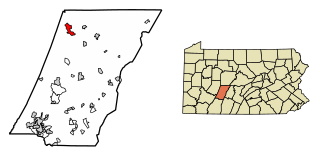
Johnstown is the largest city in Cambria County, Pennsylvania, United States. The population was 18,411 as of the 2020 census. Located 57 miles (92 km) east of Pittsburgh, it is the principal city of the Johnstown metropolitan area, which is located in Cambria County and had 133,472 residents in 2020. It is also part of the Johnstown–Somerset combined statistical area, which includes both Cambria and Somerset Counties.

Nanty Glo is a borough in Cambria County, Pennsylvania, United States. It is part of the Johnstown, Pennsylvania metropolitan statistical alrea. The population was 2,734 at the 2010 census. The name comes from the Welsh Nant Y Glo, meaning "The Ravine of Coal."

Northern Cambria is a borough in Cambria County, Pennsylvania, United States. It is part of the Johnstown, Pennsylvania Metropolitan Statistical Area. The population was 3,835 at the 2010 census.

Boswell is a borough in Somerset County, Pennsylvania, United States. It is part of the Johnstown, Pennsylvania Metropolitan Statistical Area. The population was 1,221 at the 2020 census.

Windber is a borough in Somerset County, Pennsylvania, United States, which is located approximately three miles (4.8 km) south of Johnstown. The population was 3,930 at the 2020 census. A former manufacturing town, Windber is part of the Johnstown, Pennsylvania Metropolitan Statistical Area.

Lackawanna Coal Mine is a museum and retired coal mine that is located in McDade Park in Scranton, Pennsylvania. It opened in 1903.
Crichton is an unincorporated community and coal town in Greenbrier County, West Virginia, United States. Crichton is located near the western border of Quinwood.
John Francis O'Leary was an American government official and business executive. He held top positions in the Federal Energy Administration and the U.S. Department of Energy before moving to the private sector, where he rose to chairman and chief executive officer of General Public Utilities Corp.

Joseph Austin Holmes was a geologist and occupational safety and health pioneer, best known as the first director of the U.S. Bureau of Mines. He is the namesake of the Joseph A. Holmes Safety Association created in 1916.

The Mammoth Mine disaster or Frick Mine explosion occurred on January 27, 1891 just after 9:00 AM in the Mammoth No. 1 mine in Mount Pleasant Township, Westmoreland County, Pennsylvania. Newspapers reported that firedamp was ignited by a miner's oil lamp, resulting in the deaths of 109 men and boys. Most of the miners were not killed by the force of the explosion, but rather were suffocated by the effects of afterdamp.

Scott Turner was an American mining engineer. He served as the 5th Director of the United States Bureau of Mines from 1926 to 1934 and was the 18th recipient of the Hoover Medal.
T. S. Ary was the 18th Director of the U.S. Bureau of Mines.

Vannoy Hartrog Manning, better known as Van H. Manning, was the second director of the U.S. Bureau of Mines and was instrumental in developing chemical warfare defense technologies during World War I.
John Wellington Finch was an American mining engineer and the 6th director of the U.S. Bureau of Mines.

Royd R. Sayers was an American physician and industrial hygienist. He served as the Chief of the Division of Industrial Hygiene at the National Institute of Health and the 7th director of the U.S. Bureau of Mines.
John J. Forbes was an American mining engineer. He served as the 9th director of the U.S. Bureau of Mines.
Thomas Victor Falkie was an American mining engineer and educator. He served as the 14th director of the U.S. Bureau of Mines.
Roger A. Markle was an American mining engineer and executive. He served as the 15th director of the U.S. Bureau of Mines. He later served as the president and vice chairman of Quaker State and the executive vice president of NERCO.
Lindsay D. Norman is an American mining engineer and educator. He served as the 16th director of the U.S. Bureau of Mines. He also worked as an executive for Jones and Laughlin Steel Company and Chase Manhattan Bank. He later served as president of Montana Technical Institute and Massachusetts Bay Community College.
Robert Carlton Horton was an American mining engineer. He served as the 17th director of the U.S. Bureau of Mines.










